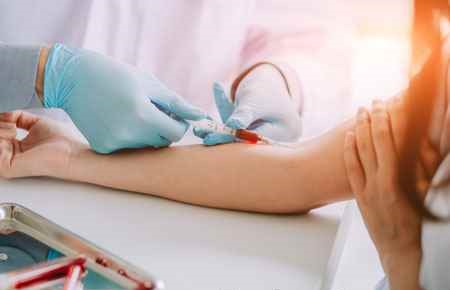
Phlebotomist
Summary
Phlebotomists draw blood for tests, transfusions, research, or blood donations.
What they do
Phlebotomists will explain their work to patients and provide assistance if patients have adverse reactions after their blood is drawn.
They typically do the following:
- Draw blood from patients and blood donors
- Talk with patients and donors to help them feel less nervous about having their blood drawn
- Verify a patient’s or donor’s identity to ensure proper labeling of the blood
- Label the drawn blood for testing or processing
- Enter patient information into a database
- Assemble and maintain medical instruments such as needles, test tubes, and blood vials
- Keep work areas clean and sanitary
Phlebotomists primarily draw blood, which is then used for different kinds of medical laboratory testing. In medical and diagnostic laboratories, patient interaction is sometimes only with the phlebotomist. Because all blood samples look the same, phlebotomists must carefully identify and label the sample they have drawn and enter it into a database. Some phlebotomists draw blood for other purposes, such as at blood drives where people donate blood. In order to avoid causing infection or other complications, phlebotomists must keep their work area and instruments clean and sanitary.
Work Environment
Phlebotomists who collect blood donations sometimes travel to different offices and sites in order to set up mobile donation centers. They also sometimes travel to long-term care centers or patients’ homes.
How to become a Phlebotomist
Phlebotomists typically enter the occupation with a postsecondary nondegree award from a phlebotomy program. Almost all employers look for phlebotomists who have earned professional certification.
Phlebotomists typically enter the occupation with a postsecondary nondegree award from a phlebotomy program. Programs are available from community colleges, vocational schools, or technical schools. These programs usually take less than 1 year to complete and lead to a certificate. Certification programs involve classroom sessions and laboratory work, and they include instruction in anatomy, physiology, and medical terminology.
Some phlebotomists enter the occupation with a high school diploma and are trained to be a phlebotomist on the job. No matter their education level, phlebotomists also receive specific instructions on how to identify, label, and track blood samples.
Almost all employers prefer to hire phlebotomists who have earned professional certification.
Several organizations offer certifications for phlebotomists. The National Center for Competency Testing (NCCT), National Healthcareer Association (NHA), American Society for Clinical Pathology (ASCP), National Phlebotomy Association, and American Medical Technologists (AMT) offer Phlebotomy Technician certifications.
Candidates for certification typically need some classroom education, as well as some clinical experience. Certification testing usually includes a written exam and may include practical components, such as drawing blood. Requirements vary by certifying organization. California, Louisiana, Nevada, and Washington require their phlebotomists to be certified.
Pay
The median annual wage for phlebotomists was $35,510 in May 2019. The median wage is the wage at which half the workers in an occupation earned more than that amount and half earned less. The lowest 10 percent earned less than $26,000, and the highest 10 percent earned more than $49,750.
Job Outlook
Employment of phlebotomists is projected to grow 17 percent from 2019 to 2029, much faster than the average for all occupations. Hospitals, diagnostic laboratories, blood donor centers, and other locations will need phlebotomists to perform bloodwork.
Blood analysis remains an essential function in medical laboratories and hospitals. Demand for phlebotomists will remain high as doctors and other healthcare professionals require bloodwork for analysis and diagnosis.
In addition to blood analysis, phlebotomists are necessary for blood collection, either at mobile blood centers or dedicated donation centers. These phlebotomists may be especially busy during a health emergency, which can correspond with heightened interest in blood donations.
Similar Job Titles
Certified Medical Assistant (CMA), Lab Liaison Technician, Laboratory Assistant (Lab Assistant), Laboratory Technician (Lab Tech), Medical Lab Assistant, Mobile Examiner, Patient Service Technician (PST), Phlebotomist, Phlebotomy Technician, Registered Phlebotomist
Related Occupations
Not provided
More Information
The trade associations listed below represent organizations made up of people (members) who work and promote advancement in the field. Members are very interested in telling others about their work and about careers in those areas. As well, trade associations provide opportunities for organizational networking and learning more about the field’s trends and directions.
- American Medical Technologists
- American Society for Clinical Pathology
- American Society of Phlebotomy Technicians
- Center for Phlebotomy Education
- Coordinating Council on the Clinical Laboratory Workforce
- National Center for Competency Testing
- National Healthcareer Association
Magazines and Publications
If you have donated blood or had it drawn for medical tests, you have met a phlebotomist. Phlebotomists draw blood for tests, transfusions, research, or blood donations. They talk with patients and donors to calm them, and help patients recover if needed. Phlebotomists also keep detailed records. They confirm a patient or donor’s identity, label drawn blood for testing or processing, and enter patient information into a database. They assemble and maintain medical instruments such as needles, test tubes, and blood vials. To avoid causing infection or other complications, phlebotomists must keep their work area and instruments clean and sanitary. Patients appreciate a successful first attempt when having their blood drawn, so phlebotomists work skillfully to maintain patients’ comfort and confidence. Phlebotomists work mainly in hospitals, medical and diagnostic laboratories, blood donor centers, and doctor’s offices. Most phlebotomists work full time, and may work on nights, weekends, and holidays depending on the setting. Most phlebotomists take a short technical training program and then test to become certified. Phlebotomists must be certified to work in some states.
Content retrieved from: US Bureau of Labor Statistics-OOH www.bls.gov/ooh,
CareerOneStop www.careeronestop.org, O*Net Online www.onetonline.org
